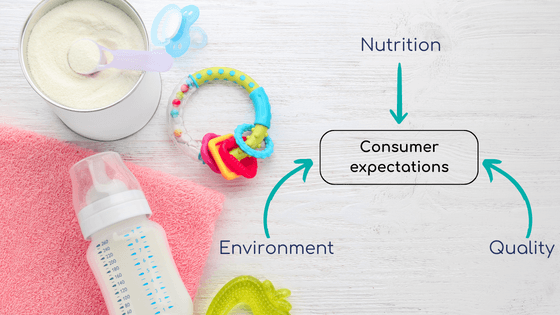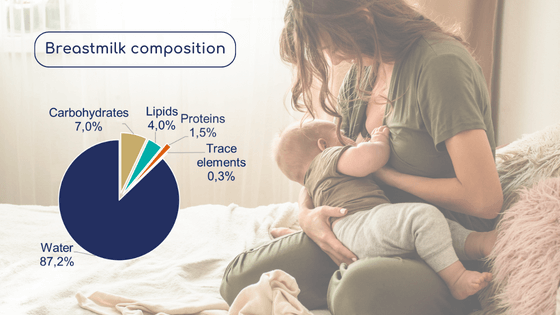
Providing appropriate nutrition for optimal infant growth
Infant nutrition is a complex subject, due to their very specific needs. Many scientific publications have shown the impact of nutrition on a baby’s growth and development, particularly in the first 1,000 days. It is therefore essential to provide babies with the appropriate nutrition, by choosing the most suitable products.
The infant formula market
The infant formula market has been growing for several years. Estimated to be worth $50 billion in 2022, the market is expected to reach $100 billion in 2033 with a CAGR of 8.5%. Most infant formula is sold in the Asia-Pacific region, but North America is experiencing the strongest growth [1–2].
The infant formula market is driven by several factors:
-
-
- The growing middle class in developing countries, and the resulting rise in purchasing power
- The increase in the number of working mothers
- And a more rapid return to work after the birth of a baby.
-
Despite these different growth factors, the market is facing a number of challenges, some of which, notably the declining birth rate, could slow market growth. Infant formula companies need to adapt to this change by offering products that are suitable for infants.
Emerging trends in the infant formula market

The infant formula market is driven by three main themes: quality, the environment and nutrition.
Parents are increasingly demanding in terms of quality. There is growing concern about the composition of infant products and the short- and long-term impacts on health. To address these concerns, products bearing labels such as GMO-free, additive-free, preservative-free, and free of artificial colourings and flavourings have become increasingly common in recent years.
Consumers are also paying more and more attention to the environment. They therefore seek to make informed purchases, preferring products that are identified as environmentally friendly.
Finally, parents’ interest in nutrition has been growing for several years. As a result, infant products with health benefits, particularly for developing the cognitive and nervous systems, along with the immune system, are in high demand. Parents are also concerned about the risk of infant obesity. Products with added sweeteners such as sugar or glucose syrup are therefore frowned upon, while the number of products launched containing only lactose is on the rise.
Breast milk: the gold standard of baby nutrition
Breast milk is the most suitable food for babies as it offers many benefits. These include improving the immune system, and reducing the risk of both infection and obesity. The World Health Organisation therefore recommends breastfeeding babies within the first few hours after birth and feeding them exclusively with breast milk until they are six months old [3].

Proteins: essential for infant growth
Breast milk is considered to be the gold standard of infant nutrition, compared with infant formula. Proteins represent 1.5% of the components of breast milk. There are two types of protein: whey proteins (around 73% of total proteins) and caseins (around 27% of total proteins) [4]. Whey proteins contain mainly alpha-lactalbumin, which helps fight infection and has an antimicrobial function [5–6]. Lactoferrin, also present in whey proteins, has an effect on the intestinal physiology and microbiota and plays a bacteriostatic and bactericidal role [5–6].
Over time, thanks to scientific research, the protein composition of infant formulas has been adapted to be as close as possible to breast milk.
Lactalis Ingredients has developed Prolacta®, a soluble milk protein. Its composition and process make it suitable for use in infant formulas. Its amino acid profile provides 40% more tryptophan and alpha-lactalbumin than standard whey proteins. This unique feature makes it possible to reduce the protein content of infant formulas while providing the necessary amount of tryptophan.
Fat: a source of energy for babies
Breast milk is made up of 4% fat, but this level may vary depending on several factors, such as diet [4]. The fat in breast milk is composed of around 95% triglycerides, followed by roughly 1% phospholipids and 0.5% cholesterol [7]. Fat requirements change rapidly as the infant gets older. In the first few months, fat accounts for 45–55% of total energy intake. This level gradually decreases until it reaches the same level as that of an adult (30–35%). Just as the quantity of fat to be provided needs to be monitored, so does the type of fat. For example, in an infant’s first six months, docosahexanoic acid and arachidonic acid are essential. Infant formulas must therefore take lipid composition into account for optimum nutrition.
Carbohydrates in breast milk
Carbohydrates represent 7% of the total composition of breast milk and are responsible for 40% of total energy intake. Lactose is the main carbohydrate in breast milk, and it has a range of benefits for infants. When it is hydrolysed, it yields galactose and glucose, which promote good brain development and energy intake respectively [8–9]. Furthermore, lactose helps the intestinal microbiota to mature. It has a low glycaemic index and a lower sweetening capacity, which means that infants do not become accustomed to the taste of sugar [10–13].
Lactalis Ingredients offers a range of demineralised whey products specifically for infant nutrition under the Laktodem® brand. Its regular mineral composition makes it easier to formulate infant formulas.
If you would like more information on infant nutrition and the use of infant formulas, please watch our webinar replay:
You can also visit our page on infant nutrition to find out about the different products suitable for this application.
Sources:
[1] Future Market Insights
[2] Global, total, overall Market Insights
[3] https://www.who.int/health-topics/breastfeeding#tab=tab_1
[4] Hennet, 2014
[5] Lönnerdal B. Bioactive Proteins in Human Milk – Potential Benefits for Preterm Infants. Clin Perinato l2016
[6] Almeida, Bioactive Compounds in Infant formula and their effects on infant nutrition and health: A systematic review. Int Journal of Food Science. 2021.
[7] Demmelmair and Koletzko, 2018
[8] Coelho AI, Curr Opin Clin Nutr Metab Care. , 2015
[9] EFSA Scientific Opinion on nutrient requirements and dietary intakes of infants and young children in the European Union. 2013 /
[10]: Szilagyi A. Chapter 2 – Digestion, absorption, metabolism, and physiological effects of lactose. In: Paques M, Academic Press; 2019
[11] Daly , Br J Nutr., 2014
[12] Natividad JM, Nutrients, 2022
[13] Van den Abbeele P, Nutrients, 2021.















